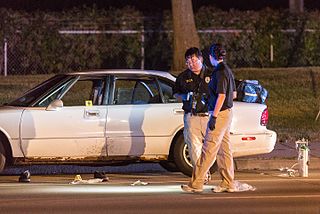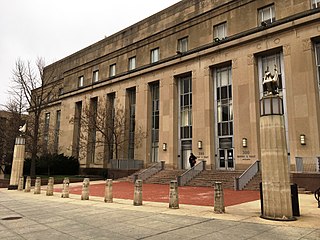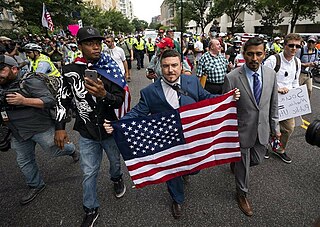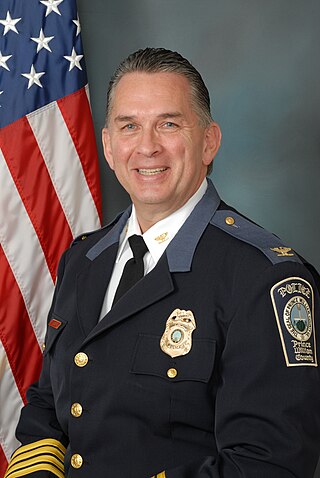
Criminal justice is the delivery of justice to those who have been accused of committing crimes. The criminal justice system is a series of government agencies and institutions. Goals include the rehabilitation of offenders, preventing other crimes, and moral support for victims. The primary institutions of the criminal justice system are the police, prosecution and defense lawyers, the courts and the prisons system.

The Violent Crime Control and Law Enforcement Act of 1994, commonly referred to as the 1994 Crime Bill, or the Clinton Crime Bill, is an Act of Congress dealing with crime and law enforcement; it became law in 1994. It is the largest crime bill in the history of the United States and consisted of 356 pages that provided for 100,000 new police officers, $9.7 billion in funding for prisons which were designed with significant input from experienced police officers. Sponsored by U.S. Representative Jack Brooks of Texas, the bill was passed by Congress and signed into law by President Bill Clinton. Then-Senator Joe Biden of Delaware drafted the Senate version of the legislation in cooperation with the National Association of Police Organizations, also incorporating the Assault Weapons ban and the Violence Against Women Act (VAWA) with Senator Orrin Hatch.

Capital punishment is a legal punishment under the criminal justice system of the United States federal government. It is the most serious punishment that could be imposed under federal law. The serious crimes that warrant this punishment include treason, espionage, murder, large-scale drug trafficking, or attempted murder of a witness, juror, or court officer in certain cases.
The year and a day rule is associated with the former common law standard that death could not be legally attributed to acts or omissions that occurred more than a year and a day before the death.

The Federal Bureau of Prisons (BOP) is a United States federal law enforcement agency within the U.S. Department of Justice that operates U.S. federal prisons and is responsible for the care, custody, and control of federal prisoners.

The Metropolitan Police Department of the District of Columbia (MPDC), more commonly known as the Metropolitan Police Department (MPD), the DC Police, and, colloquially, the DCPD, is the primary law enforcement agency for the District of Columbia, in the United States. With approximately 3,400 officers and 600 civilian staff, it is the sixth-largest municipal police department in the United States. The department serves an area of 68 square miles (180 km2) and a population of over 700,000 people. Established on August 6, 1861, the MPD is one of the oldest police departments in the United States. The MPD headquarters is at the Henry J. Daly Building, located on Indiana Avenue in Judiciary Square across the street from the District of Columbia Court of Appeals and the Superior Court of the District of Columbia. The department's mission is to "safeguard the District of Columbia and protect its residents and visitors with the highest regard for the sanctity of human life". The MPD's regulations are compiled in title 5, chapter 1 of the District of Columbia Code.

Crime in Australia is managed by various law enforcement bodies, the federal and state-based criminal justice systems and state-based correctional services.
Crime has been recorded in the United States since its founding and has fluctuated significantly over time, with a sharp rise after 1900 and reaching a broad bulging peak between the 1970s and early 1990s. After 1992, crime rates have generally trended downwards each year, with the exceptions of a slight increase in property crimes in 2001 and increases in violent crimes in 2005-2006, 2014-2016 and 2020-2021. While official federal crime data beginning in 2021 has a wide margin of error due to the incomplete adoption of the National Incident-Based Reporting System by government agencies, federal data for 2020-2021 and limited data from select U.S. cities collected by the nonpartisan Council on Criminal Justice showed significantly elevated rates of homicide and motor vehicle theft in 2020-2022. Although overall crime rates have fallen far below the peak of crime seen in the United States during the late 1980s and early 1990s, the homicide rate in the U.S. has remained high, relative to other "high income"/developed nations, with eight major U.S. cities ranked among the 50 cities with the highest homicide rate in the world in 2022. The aggregate cost of crime in the United States is significant, with an estimated value of $4.9 trillion reported in 2021. Data from the first half of 2023, from government and private sector sources show that the murder rate has dropped, as much as 12% in as many as 90 cities across the United States. The drop in homicide rates is not uniform across the country however, with some cities such as Memphis, TN, showing an uptick in murder rates.

The Minneapolis Police Department (MPD) is the primary law enforcement agency in Minneapolis, Minnesota, United States. It is also the largest police department in Minnesota. Formed in 1867, it is the second-oldest police department in Minnesota, after the Saint Paul Police Department that formed in 1854. A short-lived Board of Police Commissioners existed from 1887 to 1890.

The District of Columbia has a mayor–council government that operates under Article One of the United States Constitution and the District of Columbia Home Rule Act. The Home Rule Act devolves certain powers of the United States Congress to the local government, which consists of a mayor and a 13-member council. However, Congress retains the right to review and overturn laws created by the council and intervene in local affairs.
The National Capital Revitalization and Self-Government Improvement Act of 1997, also known as the Revitalization Act, was enacted on August 5, 1997, with provisions to reform the criminal justice system in Washington, D.C. The act was spearheaded by North Carolina Republican Senator Lauch Faircloth.

Violent Crime Impact Teams (VCIT) in the United States work proactively to identify, disrupt, arrest and prosecute the most violent criminals through innovative technology, analytical investigative resources and an integrated federal, state and local law enforcement strategy along with the leading federal law enforcement agency for the VCIT, the Bureau of Alcohol, Tobacco, Firearms and Explosives (ATF).
The District of Columbia Department of Corrections (DCDC) is a correctional agency responsible for the adult jails and other adult correctional institutions for the District of Columbia, in the United States. DCDC runs the D.C. Jail.

Crime in Minnesota encompasses a wide range of unlawful activities that occur within the state, regulated by both state and federal laws. While crime rates in Minnesota are generally below the national average, certain areas and types of crime have garnered public attention.
Graham v. Florida, 560 U.S. 48 (2010), was a decision by the Supreme Court of the United States holding that juvenile offenders cannot be sentenced to life imprisonment without parole for non-homicide offenses.

Incarceration prevention refers to a variety of methods aimed at reducing prison populations and costs while fostering enhanced social structures. Due to the nature of incarceration in the United States today caused by issues leading to increased incarceration rates, there are methods aimed at preventing the incarceration of at-risk populations.
Rivers Correctional Institution is a privately owned prison in unincorporated Hertford County, North Carolina, operated by GEO Group under contract with the Federal Bureau of Prisons since its construction in 2001. The prison, on 257 acres (104 ha) of land, was specially built to house prisoners from the District of Columbia. It is about 1 mile (1.6 km) from the town of Winton and about 200 miles (320 km) from Washington, DC.

The Henry J. Daly Building is located at 300 Indiana Avenue, NW, and 301 C Street, NW, in the Judiciary Square neighborhood of Washington, D.C., United States. The administrative building is owned by the government of the District of Columbia and has served as the home of various city offices since it opened in 1941 as a unified location for previously dispersed municipal functions. Currently, the building is primarily occupied by the Metropolitan Police Department; although the District of Columbia Department of Corrections, the District of Columbia Office of the Chief Financial Officer and the Court Services and Offender Supervision Agency (CSOSA) also maintain offices in the building.

The "Unite the Right 2" rally was a white supremacist rally that occurred on August 12, 2018, at Lafayette Square near the White House in Washington, D.C., United States. It was organized by Jason Kessler to mark the first anniversary of the 2017 Unite the Right rally in Charlottesville, Virginia, which ended in deadly violence and attracted both national and international attention.

Peter Newsham was the Chief of Police of the Metropolitan Police Department of the District of Columbia (MPD) from January 2017 to January 2021. He is currently Chief of the Prince William County Police Department in Virginia, having been appointed to that post in November, 2020.














